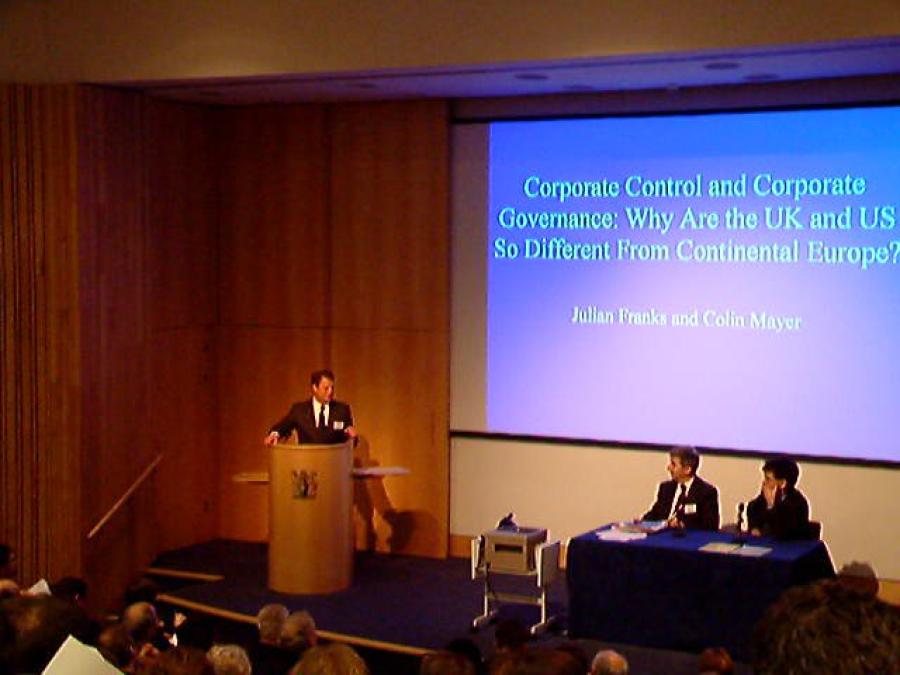
Annual Members Meeting 2004
The ECGI Annual Members Meeting 2004 took place on 10 March 2004 in London, UK. The event comprised of the AGM, an Annual Lecture and a dinner.
2004 Interim Report
A report showing the ECGI's progress in its first nine months of 2004 can be found on this website. Click here to access the whole report.
The presentation was preceeded by opening remarks from Dr. Laura D'Andrea Tyson, Dean of the London Business School. Introduction by Antonio Borges, ECGI Chairman.
ECGI Annual Lecture 2004
The title of the 2004 Annual ECGI Lecture was "Corporate Control and Corporate Governance – why are the US and UK so different from continental Europe?". The lecture was given by Professor Colin Mayer, Peter Moores Professor of Management Studies (Finance), Said Business School, University of Oxford and Professor Julian Franks, Professor of Finance, London Business School.
Speakers
Colin Mayer
Gallery
Interim Report 2004
INTRODUCTION
At this stage of the year, it is customary for me to review the progress that the Institution has made since I last reported to you all at our General Assembly in March. I am very pleased to tell you that the ECGI has been very active on a number of fronts and we continue to plan an exciting forward agenda.
OUR SECOND ANNUAL GENERAL ASSEMBLY
Our third year of existence could not have got off to a better start, judging by the number of members who supported our General Assembly in London at the London Business School. I was particularly pleased to hear such positive feedback and constructive suggestions from those present. I think I can say that the consensus of the meeting, using the words of one member, was “that the quality of what the ECGI does is just outstanding” and “that the forward agenda is exceptionally thoughtful”.
The subsequent lecture by Colin Mayer and Julian Franks was not only up to their usual high standard but also gained the ECGI many new friends, being open to and attended by a large gathering of LBS MBA students.
TRANSATLANTIC CORPORATE GOVERNANCE DIALOGUE
The highlight of the last six months has undoubtedly been the inauguration of the Transatlantic Corporate Governance Dialogue. This is a major new ECGI initiative and, we hope, the first event of a long series. The TCGD is a forum for debate and for the exchange of experiences across the Atlantic. We believe it will make a significant contribution towards better corporate governance on both sides of the Atlantic.
As you are aware, the European Commission has been involved over the last few years in a major effort to develop and improve financial markets in Europe through an Action Plan that is now nearly concluded. Corporate governance is a crucial component in that effort and, in discussion with the Commission, we sought ways of making a contribution. We arrived at a proposition for a forum for dialogue across the Atlantic where we Europeans could present our views and debate them with our fellow Americans. We found an ideal partner, the American Law Institute (ALI) to help us. We devised a topical and informative programme for the launch and it was no surprise that there was literally only standing room left at the Maison de l’Europe.
The morning session looked at the European experience and its implications for the United States. The expert European panel consisted of Eddy Wymeersch, University of Ghent; Gerard Hertig, Swiss Institute of Technology; Colin Mayer, Saïd Business School and David Wright, European Commission, Internal Market and Financial Services DG. This was moderated by Klaus J. Hopt of the Max Planck Institute for Foreign Private and Private International Law.
The afternoon session considered the implications on Europe of the US experience, particularly following the federal Sarbanes-Oxley statute. This session was moderated by Lance Liebman of the American Law Institute, our partner in the TCGD. His panel of experts comprised Ronald Gilson, Columbia University; Melvin Eisenberg, University of California, Berkeley; Mark Roe, Harvard Law School and John Coffee, Columbia Law School.
Alexander Schaub, Director General, European Commission, DG Internal Market had supported the TCGD from the outset and we were delighted when he agreed to be a keynote speaker. Mario Draghi, Vice Chairman and Managing Director, Goldman Sachs International and Harvey Goldschmid, Commissioner, United States Securities and Exchange Commission, the other distinguished keynote speakers, offered further insight and comment.
It was an excellent day when a great deal of knowledge and experience was communicated and shared. There was a good debate and we could not have hoped for a better launch of this initiative. We are now planning a further event in the US next year to continue the dialogue ‘away from home’.
TRAINING NETWORK
At our General Assembly, I touched on the protracted bidding process that led to our success in gaining EU funding for a training network which aims to reduce the European corporate governance research and training gap. This ambitious four-year programme has recently started with active recruitment of applicants for Early Stage Researcher Fellowships. Details of the inaugural Network Conference which takes place on 28-29 January 2005 in Oxford, hosted by the Saïd Business School, can be found on a website devoted to the ECGTN (http://www.ecgtn.org/).
ECGI CLINICAL PAPER COMPETITION
The entry date for the submission of papers to the ECGI Clinical Paper Competition has now passed and I am pleased to say that we have had a high quality response. We launched this competition earlier in the year with the aim of encouraging the writing and publication of empirical research papers on corporate governance cases in Europe. Six papers were selected and went to the jury. The winners were announced in Stockholm on 9 December in a ceremony to coincide with Nobel Prize week with the first prize going to Colin Mayer, Julian Franks and Stefano Rossi for their paper ‘Ownership: Evolution and Regulation’. Details of all the prize winners can be found by clicking this link.
EXPANDING OUR MEMBERSHIP
At our last General Assembly, we sought and obtained approval of the members to introduce a new category of membership, the Research Member - an automatic membership for current and future ECGI Fellows and Research Associates during the term of their research fellowship. At the time, some 58 new Research Members were created. They have been augmented by a further 23 Research Associates who were nominated in June.
Our other categories of membership continue to expand too. Since the General Assembly, there have been 7 new Institutional Members, 31 new Ordinary Members and 27 new Academic Members.
I would like to thank all of you whether individually or on behalf of a corporate entity, for supporting us through your membership of the Institute. Again I would ask you to encourage your colleagues and business acquaintances to join you as members.
HIGHLIGHTING RESEARCH THROUGH OUR WEBSITE
Research is at the heart of what the ECGI stands for. For this reason, we have introduced a new ‘portal’ on the ECGI website with links to every aspect of our research output, debates and resources. Every two months, we highlight the work of a different Research Member, thereby bringing to the attention of a wider audience perhaps the important work they are doing in this field. It is a wider world if the statistics for our website’s usage are to be believed. We now attract over 20,000 visitors a month and regularly feature as one of the leading corporate governance websites in search engine listings. Such figures may not seem important under normal circumstances. ECGI, however, is a virtual organisation where the internet plays a key role in establishing our reputation and delivering benefits to members.
For those who do not access our website on a regular basis we have recently introduced a short factual online News Update. We intend to send this out regularly to keep you abreast of our activities.
LOOKING AHEAD
Looking ahead, I would ask you to make a note for your diaries about the next General Assembly. This will take place on Wednesday, 9th March 2005 at SDA Bocconi, Milan. We are grateful to Dr Andrea Gasparri for agreeing to host this and the annual lecture which follows it.
My next report to you will be made at that meeting. In the meantime, I trust that the ECGI will continue to have your support as it seeks to achieve our shared aims.
On behalf of the ECGI Board, season’s greetings to you all and very best wishes for the New Year.
Antonio Borges, Vice Chairman, Goldman Sachs International, Chairman ECGI
December 2004
Opening remarks by Dr. Laura d'Andrea Tyson, Dean of London Business School
I’m really delighted to be here tonight to welcome all of you to the European Corporate Governance Institute Annual Lecture. The co-hosts of this lecture of course are the Institute itself and the Institute for Finance and Accounting at London Business School. I remember talking to Julian more than a year ago about the possibility of our being the co-hosts of this event and I really am delighted that we were able to organise it and to be with you tonight.
The IFA, for those of you who don’t know the other Institute tonight is the Institute of Finance and Accounting. It is one of the world’s largest and best-known centres for financial education and research. Located at the school we have 23 faculties from 11 countries making it by far the largest finance group outside of the United States. The IFA carries out teaching and specialised finance programmes, including the Masters of Finance and Corporate Finance evening programme and Investment Management evening programme and they also work in all of our general management MBA programmes. They act as consultants to financial institutions, industry and government; they hold directorship in a large number of organisations and their work as advisors, as consultants and as researchers helps them very much with their research and also to bring practical relevance in the teaching of our students. The IFA’s research work is made possible through the generosity of a network of companies, individuals, charitable foundations and public organisations. So we’re very thankful for all of those who have made possible the research agenda of the IFA.
Now tonight you are going to hear from one of the IFA’s most distinguished faculty members. I am not going to introduce him because that is Antonio Borges’s job but just let me say that Julian Franks has been leading an effort within the IFA to bring together a large group of faculty, all of whom are working on various aspects of corporate governance and it has been very exciting to me because I personally am engaged in a number of boards of directors and I also have been thinking about the issue of corporate governance for quite some time to see the energy and commitment of the finance group to this very important area of study. Julian has been very important in leading that effort.
Let me, without further ado, introduce Antonio Borges, who is the Chairman of the European Corporate Governance Institute and he in turn will introduce the speakers. Thank you very much.
Introduction by Antonio Borges, ECGI Chairman
Thank you very much Laura. It’s a great privilege to be here at the London Business School. Thank you to all of you for attending this event. We have many of our members here today - we have just held our Annual General Meeting and as is now customary, we arrange a lecture to follow. We especially appreciate this lecture being hosted at the London Business School. I myself was in the academic economic world for many years and I believe academic institutions have an enormous responsibility in many ways, but in particular in the field of governance. Not only do they conduct the research necessary to promote good governance but they also to train and educate people.
I'd just like to say a few words about the European Corporate Governance Institute. We are a very young institution. This is only the beginning of our second year of operation. We are completely independent and exclusively sponsored by our membership. We already have, however, a large number of individual and institutional members. Our main goal is simply to promote scientific research to generate new knowledge, to disseminate that knowledge such that it leads to better practice in corporate governance. It is our firm belief that governance is a matter that deserves study: that it cannot be taken over by preconception or prejudice; it should not be conducted in an ideological manner. It does require in-depth serious and very often empirical research. We want to promote that research; we want to disseminate it to make it available to all those who share our interest and in the process, promote better governance practices.
Now what we are going to hear today is probably one of the best examples of what we try to do. We get some of the best researchers in the world to devote their time and effort to substantial governance issues, to do the right research, to publish it, to disseminate it and then to debate it.
We are very privileged to have here with us today some of the very best researchers in this area. I will not spend a great deal of time introducing them because I think they are very well known. Julian Franks and Colin Mayer are part of a new generation, if I may say so, of a young generation of academics who have taken up the challenge of promoting research at the highest level throughout Europe. I think we’re now at the point where we can say there are areas of academic research where we are at the forefront of new knowledge, where we can compete with the very best in the world for academic excellence and these are some of the most representative symbols of that effort with a European base, with a focus on Europe but with standards which are just as high as anywhere else in the world.
We are very fortunate at ECGI that both of them are Fellows of the Institute, both of them devote their efforts to our cause and both of them are prepared to share their time and energy with us. Colin, Julian, thank you very much for coming to our annual event and I’m sure we all appreciate what you have to say.
2004 Annual Lecture
Corporate Control and Corporate Governance:
Why are the UK and US so different from Continental Europe?
Lecture - Part 1 | Colin Mayer
Corporate Control and Corporate Governance: Why are the UK and US so different from Continental Europe?
Thank you very much, Antonio. One of the most active debates that we’ve had in the European Corporate Governance Institute over the last few months is about the title of this talk. Whether or not it should say “Why are the UK and US so different from Continental Europe?” or “Why is Continental Europe so different from the UK and US?” – a small difference you might think, but quite a significant one. Actually, there’s really no substance to that debate because, as I’m sure you’ll all agree, Britain is a strange country – a very strange country.
But I’m not just talking about the nature of its individuals but more about its corporate identity. Most countries in the world have concentrated ownership; Britain doesn’t. Most countries in the world have families as their dominant corporate owners; Britain doesn’t. In most countries there are a variety of mechanisms that companies use to avoid external control, in particular from shareholders; in Britain they don’t. Instead in Britain we’ve got an active market in corporate control and most countries in the world don’t. Just to illustrate some of these points let me begin by telling you a little bit about the ownership of companies in different countries round the world.
This slide refers to the degree of concentration of ownership in a number of European countries and some of the markets in the US. What it shows is the proportion of companies listed on their stock markets that have a single shareholder owning more than 50% of shares in the company. In other words, in what proportion of companies is there a single shareholder with a majority of votes in a company? The answer is in Austria it’s around 68% of listed – that’s the largest – companies have a single majority shareholding. In Belgium 66% and you can see the other countries listed here in Continental Europe – it’s not very distant; it’s slightly lower in the Netherlands, Spain and Sweden.
But if we compare those numbers with what it is in the UK and the US, the differences are dramatic. In the UK in just 3% of listed companies is there a single shareholder with a majority of shares in the company and in the United States the figure is about the same. Instead in Britain if one wants to control a firm one has to get together a coalition of shareholders so not only are there no dominant shareholders, but the largest shareholders don’t have shareholdings that are very different to the next largest shareholder or the third largest shareholder as this slide has illustrated. So on average largest shareholders in British listed companies have a shareholding of around 14%, the second largest shareholder is round about 7%, etc. So you can put together a coalition of around six shareholders, essentially institutionally shareholders, that together will command around 30% or so of the shares in the company. But if one wants to be able to exercise control over a British firm one needs a coalition of shareholders.
And it’s not only in terms of the size of shareholders that Britain is quite unusual relative to its Continental European counterparts, it’s also in terms of the nature of those shareholders. In most countries round the world the dominant shareholders are either families or other companies. This slide illustrates the case of Germany and shows that of those large share blocks, around 30% or so are associated with families and just under 30% are associated with other companies holding dominant shareholding in the form of pyramids or cross-shareholdings in each other. In contrast, as you’ll probably appreciate, in the UK the dominant shareholders are financial institutions so that to the extent that there are sizeable share blocks then around 60% or so of them are associated with pension funds, life insurance companies, mutual funds, etc. The other large holders of share blocks are insiders, directors of companies.
The type of shareholdings that exist in most countries round the world are very different from those in the UK. Not only do shareholders exert control through having large share blocks, they also do it through a variety of mechanisms; pyramid structures are very common in many countries – so too are what I illustrate here: dual-class shares. So, for example, the German car company, Porsche, has family holdings amounting to just 10% of the cash flows of the company but 100% of the voting rights. So there are two classes of shares in Porsche and the family holds the shares with the high voting rights attached to them and holds all of those shares, whilst it only holds a relatively small proportion of the shares with little or no voting rights attached to them.
In Britain we, for the most part, do not have dual-class shares, we do not have pyramid structures and we do not have those type of obstruction to exercise control by outside shareholders. Now it’s not only by the standards of European companies that Britain is unusual – it’s also unusual by the standard of many other countries around the world and I illustrate just two others here – Canada and Japan. Canada is dominated, like much of Continental Europe, by family holdings in the form of pyramid structures, an extensive range of pyramid structures of Canadian firms. Japanese companies have extensive cross-shareholdings between companies most closely associated with the correct concerns but also generally observed amongst Japanese companies.
Now the feature that this slide brings out is not only that the UK and the US are unusual in having widely held shareholdings, but also the diversity of shareholdings that are observed around the world – corporate, family, widely held institutional shareholdings. If one went to other countries one would observe different patterns of ownership again.
Now the questions that this raises is: has this diversity always existed and has Britain always been unusual or has it only recently acquired that particular characteristic? Well this slide takes you back 100 years; it takes you back to the ownership of firms at the beginning of the 20th century and it shows you that at the beginning of the 20th century the picture around the world was very different. It’s a picture of essentially domination of corporate holdings by families, virtually universally. It also brings out the fact that even then, a hundred years ago, Britain was rather unusual because even then there was some evidence of wide share ownership emerging amongst many British companies. They were getting listed on stock markets but not only were they getting listed, their shareholding was getting dispersed. So we start off at the beginning of the 20th century with a great deal of uniformity, slight disparity in the case of the UK and we end up at the end of the 20th century with a massive degree of disparity.
So how did we go from here to there? What was the process by which we got such a high degree of disparity? Well one might think there were three possible courses that the world took over those hundred years. It may have followed an essentially linear process, moving steadily in the direction of the patterns that we then observed at the end of the 20th century. On very prevalent theory of that sort of gradual progression is associated with Chandler who suggested that corporations evolved from essentially being dominant, owner-controlled companies to being owner owned but managerially managed to then being dispersed ownership and then essentially then controlled by management. So according to his view of the world there is this sort of linear progression from one stage to the other. Now one might not hold to that particular point of view but one might say, well perhaps the changes that occurred during the 20th century were closely related in different countries so they moved in similar directions at particular points in time and so the changes were correlated across countries. And the third view one might have is, well it was all pretty random and not even correlated across countries.
Well this is what happened essentially in the first three decades of the 20th century. During those first three decades basically what happened looked very much in line with the Chandler view of the world – of a gradual linear progression from family ownership to dispersal of ownership. It happened at different stages in different countries, as I’ve already mentioned. It happened rather earlier in Britain than in many other countries around the world but, as this slide illustrates, basically they were all moving in tandem towards greater degrees of dispersion, towards what one might term a sort of Anglo-American view. But then there was a major shock and the shock of course was the Second World War and around the time of the Second World War one begins to observe some disparity emerging. Canada, the UK and the US continue over the subsequent three decades up until the end of the 1950s along this path of increasing dispersion of ownership but Germany and Japan don’t. Japan does actually for much of the 1930s continue to display increasing dispersion but then, during the 1940s, there’s progressively increased intervention by the state. In Germany we begin to observe increasing ownership by families once again in the period up to and including the war.
And then, after the war, in Japan, as a consequence of the intervention by the allies, breaking up the family firms that existed, for a brief period, perhaps getting on for a decade, there was widespread ownership much along the lines of Anglo-American model with a quite active market in corporate control. But it’s then, in the last three decades, that we really observe the dramatic differences and changes that are a feature of today. So Canada goes on being widely held through much of the 1960s but then, rather paradoxically, switches back to family control and domination for the last two decades of the century. In Germany the procedure by which families were beginning to take control during the 1930s and 1940s continues in the Second World War and is backed up by increasing ownership across countries in the form of pyramids and cross-shareholdings. And perhaps the most remarkably of all, Japan switches very suddenly from being a country with Anglo-American characteristics of wide share ownership in a market for corporate control to being the one that we observe today of anything but an active market for corporate control and a great deal of cross-shareholdings across companies.
So the first point that I think I’d like to convey this evening is that what we observe today in terms of the pattern and disparity across countries is a post-Second World War phenomenon, at least it’s a post Second World War phenomenon is some of the countries that I’m looking at here though the seeds of that wide-dispersed ownership were sown in the UK and the US right at the beginning of the 20th century. And that’s a point that we’ll come back to later. So the progression was far from linear during the 20th century. It was correlated across countries before the Second World War, it was very divergent around the Second World War and then the patterns that emerged post-Second World War were very different across countries.
The obvious question that this raises is why? Why did the patterns that we observe today emerge? Why was the process, the change so very different across countries and why is it that we observe apparently long-run patterns existing for a hundred years in at least two countries, the UK and the US and not elsewhere? There is one view that has come to dominate not only the academic debate on ownership and control of companies, but also the policy debate and policy recommendation that that implemented around the world. And that view is one of the importance of regulation in the promotion of markets, that regulation is central to the successful development of financial markets around the world.
Actually there are two quite widely held views about the influence of regulation which point in quite different directions. The first one argues that the dispersion in ownership that we observe in the United States today was a consequence of regulation primarily enacted during the 1930s, but not exclusively in the 1930s, in response to a populous agenda that was emerging of limiting the concentration of power in the hands of dominant shareholders. And that populous agenda started right back at the end of the 19th century in the form of the Sherman Act, the anti-trust act of the 1890s, the Clayton Act during the beginning of the 20th century, the Glass-Steagall Act in the 1930s, breaking up relationships between commercial and investment banks, and the Public Utilities Holding Act preventing utilities from having the then prohibited pyramid structures of holding companies in each other. That’s the first view – that regulation forced dispersed ownership on unwilling companies in the United States during the first three or so decades of the 20th century.
The second view is essentially almost directly opposite to that. It argues that regulation is necessary to encourage dispersed ownership; it doesn’t force dispersed ownership on companies – if you don’t have good regulation you won’t get well-functioning markets; you won’t get a lot of finance being raised on financial markets and you won’t get dispersed ownership. Why? Because if investors do not have good investor protection then the only way in which they can actually get protected is by having large shareholdings in companies and exerting direct voting control over those firms. So this view argues that the reason why we’ve got well developed market, particularly in the UK and the US, with large amounts of dispersed ownership, is that this was promoted by the common law system that we have in the UK and the US and the high levels of investor protection associated with those common law systems.
The implications of these views are obviously very different. According to the first point of view regulation essentially undermines the efficient workings of an economy; it prevents shareholders from accumulating large blocks in companies and thereby having the incentive to engage actively in the monitoring and governance of firms. So according to that view regulation is a bad thing and it gives rise to bad outcomes and, in particular, poor corporate governance. According to the second view point, on the contrary, regulation is required to the successful development of markets and it’s the explanation for why markets are better developed in some countries such as the UK and the US than elsewhere.
So the question that this raises is: should we praise or condemn regulation? Should we regard it as being a saviour of the financial market or as essentially undermining their efficient operation? And what we’re going to try to do to answer that question is essentially to go back, to retrace those steps that I’ve described back to the beginning of the 20th century and see what happened at the beginning of the 20th century before we had regulation in place. How well did markets operate in the absence of well-regulated markets?
To answer that question I will of course now turn over to my colleague.
Lecture - Part 2 | Julian Franks
As Colin has said, the UK is really interesting. It’s interesting because there was a pervasive lack of regulation and investor protection for at least the first half of the century. Indeed for most of the century, at least until the 1970s, there were no restrictions on block ownership in Britain. Competition law was very weak, unlike in the United States with its anti-cartel legislation. Minority protection was weak, certainly until the middle of the century, and according to some Law Lords, until the 1970s. What contributed to this lack of protection? What contributed to this lack of protection at least for minorities? Paradoxically common law contributed to it.
In a very famous case in 1843, known as Foss and Harbottle, a case that established one fundamental fact - that strict majority rules, a case that was to prevail in England, at least according to Lord Justice Hoffman, until the 1970s when minority protection was brought into England. This case established two important features: that when a wrong is done to a company, say by the Board of Directors, the proper plaintive was the company itself, not a shareholder. And secondly and crucially, that if a strict majority of shareholders approved the actions of the Board of Directors then that was the end of it, regardless of whether a large minority disapproved of it. If you like, the matter admits of no further argument.
What were the implications? What might we expect to observe in our experiment in our laboratory of Britain in the first half of the century? We might expect to observe underdeveloped financial markets; underdeveloped – by that I might mean small capital markets, a low number of listed companies. We might expect to observe block ownership of shares just like we see in many countries in Continental Europe today, that is, we might expect to see concentrated ownership. We certainly would expect to see little external equity financing; after all, who would buy the equity in the absence of investor protection or regulation? We might also expect to see considerable abuse of minority investors. That is in take-overs, for example, we might expect to see the large shareholders earning much higher returns than small shareholders. This is what we would expect to see in the experiment we’re about to conduct.
Why do I talk about the first half of the century? Because around the middle of the century there was an earthquake in terms of investor protection and regulation in Great Britain. The earthquake came in two stages which were very much linked. First the Stock Exchange introduced dramatically new listing rules for companies on its Stock Exchange. Secondly, the 1948 Companies Act substantially improved disclosure requirements of listed companies in Britain and moreover gave powers to dissident shareholders or to small shareholder groups to call for extraordinary general meetings. 1948 for the middle of the century was a landmark in terms of investor protection.
What this study tries to do is to look at two sets of companies. First, one set collected at the beginning of the century and here we trace the evolution of ownership control for the next hundred years. We look at the dispersion of ownership; we look at who controls the company; we look at how family holdings develop over those years. And then we compare it against the benchmark and that benchmark is a sample of companies that accessed our capital markets in 1960 after the introduction of legislation in the middle of the century.
And you can see one of the immediate results that you might expect from our data and that is substantially greater dispersion of ownership in our benchmark data set compared with that in our 1900 data set. That is, dispersion should be much greater after 1950 than before 1950. What are the results? Instead of small capital markets, instead of a low level of listed companies we see large and flourishing stock markets in the UK at the beginning of the century. We see 19 stock exchanges, most of them provincial stock exchanges – Bradford specialising in textile stock, Sheffield in steel and coal and Oldham, now only famous for its football team, was the second largest stock market after the London Stock Exchange in the very early part of the century. Several thousands of stocks were traded and large amounts of equity were issued – a compound rate of 10% per year. Indeed, the rate of growth of equity in the first half of the century is remarkably similar to that in the second half – very different from the expectations we had from the law and finance hypothesis that Colin talked about earlier.
In the last slide I talked about the substantial issuing of equity. I have to say here, in our sample we found no pyramid, we found now dual-class shares in the first half of the century in our sample. (see slide) Much of the equity that was issued was there to finance acquisition. Interestingly enough, even in the absence of investor protection, target shareholders did not demand cash but, on the contrary, took equity. Most of the equity that was issued was to finance these acquisitions; relatively little was for internal investment. Even in the absence of a takeover code there was no discrimination between large shareholders and small shareholders. There was, if you like, in the language of our current takeover code, an equal price rule. Directors of companies accepted the same price for their shares as they offered to outside shareholders, big and small - again, contrary to the expectations of the law and finance hypothesis.
The large scale takeover activity had several important results. The first I’ve already spoken of – it led to the issuance of equity and to some extent explained the dispersion of ownership in the first half of the century. But, more than that, it explained the decline in insider holdings and more specifically it explained the decline of family holdings, especially the founding family. In one decade 40% of the declining directors’ ownership was the result of the issuance of shares in acquisition activity. It should come as no surprise that ownership concentration declines immediately after the beginning of the 20th century but dispersion of ownership is very little different between these two halves of the century.
And I just want to give you a few statistics. In the first column what we see is the minimum number of shareholders required to form a coalition of 25% of the voting capital. In 1900, not surprisingly, out of the sample of 20 companies that makes up this table, only two shareholders on average were needed to form a coalition of 25%. By 1940 it had risen to 18 shareholders; that was the minimum number of shareholders required to form a coalition of 25%. And by 1980 it was 58 and then, with the rise of institutional shareholding, it fell back to 48. That is, the dispersion of ownership proceeded relatively quickly. In the second column we look at the number of companies where the founding family holdings were greater than 25%. It shouldn’t come as a surprise that in 1900 18, almost all of our companies, had family holdings greater than 25%. By 1940 it had been reduced to eight and, as you might expect by now, it is zero. And all these companies, by the way, that I’ve chosen still exist today. In the third column we look at, if you like, the number of companies where the largest shareholder was an institution and perhaps not surprisingly that in the first half of the century it was either zero or something like four.
Only in the second half of the century do we see really the rise of institutional shareholding, although by 1980 it was still only eight. By the year 2000, in 17 out of our 20, the single largest shareholder was an institutional shareholder. What are these statistics are supposed to illustrate? If you like, the increasing dispersion of our shareholding, the decline of the family holdings and the rise of institutional holdings. All these results point in one direction – a flourishing capital market in the absence of investor protection, substantial equity issue, little evidence of minority investor abuse especially in takeovers. How did all this happen with no Financial Services Authority, no Securities Investment Board? How is this possible? This may seem like a dream to you – or to regulators, possibly a nightmare. I wasn’t being serious by the way because there are some in the audience tonight.
How did equity issuance occur in the absence of investor protection? The answer is one word and that is trust. Companies were largely dependent on local stock markets for the raising of their capital. Directors as a result were concerned to maintain the value of their equity and in doing so, they largely upheld the interests of minorities for this purpose. How did they uphold the interests of minorities? The answer – as men of distinction, name and reputation - the association of people with reputation and, although it’s unfashionable, people with titles and reputation. These were economists who seemed in those early days to value name and reputation in our capital markets. Minority interests were also upheld, if you like, by the game of cricket. Cricket, for those of you who don’t understand the rules, can be summed up in one phrase: fair play. That is, the boards of directors largely felt an implicit contract with shareholders; that is, they had to uphold the right of minorities.
Chairmen of companies talk of themselves as trustees and May, an economist of the time, talked of management practice going well beyond the letter of the law. Shriver and Somers might be talking of implicit contracts. Minority rights were also upheld through local directors, through local financing. Trust was reinforced by the close physical distance between directors and shareholders. Locality was important. Lavington, writing at the time, talks about an absence of prospectuses, arguing that where they’re placed by private negotiation among local people who understand the trade, these proved unnecessary.
In more quantitative terms Colin and I have looked at a sample of companies and looked at how many shareholders lived locally to where the company’s head office and operations were. In Guest, Keen and Nettlefolds, a company which lives on today and is associated with car parts and aircraft parts, in GKN, 40% of shareholders in 1910 lived within five miles of the centre of Birmingham. Interestingly, by the middle of the century, when the rise of investor protection began, less than 5% lived within five miles of the centre of Birmingham. That is, trust was upheld by geographic concentration of shareholding and the introduction of investor protection, the rise of investor protection was associated with the decline of geographic concentration and rather with a geographic dispersion of shareholding that coincided with the large scale expansion of companies. It may be that this geographic dispersion caused the decline in trust and thereby gave rise to the need for investor protection.
And finally, in terms of minority rights, we also see families remaining on the boards of companies well beyond the time when they gave up their shareholding. You might remember Sir Adrian Cadbury remaining as Chairman of Cadbury-Schweppes well beyond the sale of all his family holdings in the company. While ownership of families declined and was diluted, families retained control through board representation well beyond their entitlements of ownership.
And here is a little example where we compare again for our sample of companies at the beginning of the century. We compare the percentage of board representation minus the percentage of family ownership – a negative sign indicates that board representation is less than family ownership; a positive sign that board representation is greater than family ownership. And we see it was negative in 1900 but by 1940 it becomes strongly positive and it remains positive for most of the century – that is families stayed on boards well beyond the time they gave up their ownership.
Can regulation possibly explain dispersion in the UK capital market that Colin described in his early slides? And the answer is unequivocally no. Rather we would claim that informal relationships based on trust were at least as important, or were at least important until the middle of the century. It may be that regulation substituted for trust as firms expanded beyond their local market and as firms had a shareholder base well beyond their local market and well beyond the local stock exchange.
How does this compare with the United States? In what sense do the two countries have common roots? Means, one of the twins of Berle and Means, in 1930 published an article which included the share ownership of three companies, AT&T, Pennsylvania Railroad and US Steel and here you see, along the horizontal access, years and on the vertical access the number of shareholders. And what need explaining is that in 1916 or about there was a tremendous rise in the number of shareholders in these companies and a tremendous increase in their dispersion. He goes on to show that by 1930, in examining the top 200 companies – the top 200 US corporations in the States, both listed and unlisted – he finds that about 138, almost 70%, were either controlled by management, meaning that there was no large blockholder or there was only minority block ownership. That is, in the space of 30 years, US capital markets had gone from being dominated by the family magnates, like the Rockefellers and the Morgans, to being relatively dispersed, where the separation of ownership and control was largely entrenched in the US capital market. (see slide) And of course they bemoaned this fact – they regarded this as a serious disadvantage to the US economy.
Why did ownership get so dispersed in the United States? What caused this change from the concentrated ownership right at the beginning of the century to 1930? How did it get from one to the other? Becht and De Long have traced back some of the widely held firms in Means’s sample at the beginning of the 1930s and they’ve traced them back to large holding companies and trusts at the beginning of the century. What they find is one of the great causes of dispersion was merger waves. That was merger waves which involved issuance of shares – this had some resonance with what I described to you in the United Kingdom, that these merger waves involved large scale issuance of shares and, as a result, dispersed ownership. This large scale issuance of shares and merger waves was the result of severe anti-cartel legislation which encouraged companies to acquire other companies as a substitute for cartels.
To what extent does dispersion in the UK and US have common roots? As I have said already, acquisitions and merger waves may be critical to these roots. Both in the UK and the US acquisitions were the key to the issuance of equity and the dispersion of ownership. Secondly, families sought to retain board control well beyond the time they relinquished ownership and the issuance of these shares occurred largely in the background of unregulated markets and weak investor protection in both countries.
Legal judgements also have their parallels in the US and the UK. Two judgements are particularly interesting. First, in the New Jersey Court of Chancery, the court decided unconditionally that a majority of directors – their word would prevail – a strict majority. This had echoes of Foss and Harbottle, - little protection for minorities. In the Pennsylvania Supreme Court – we put this in as possibly a comfort to current directors – in those days not even gross negligence would allow you to be convicted in a court. Only fraud and theft was a justification; I see some of you looking wistfully. And indeed, in the United States until recent years, law suits against directors were relatively and the damages awarded against them were relatively small.
Of course, in the United Kingdom, to beat the United States it was almost impossible to successfully sue a director for negligence. Successful law suits were a rare event; maybe with Equitable Life this is about to change. But there are certainly parallels here in terms of governance.
How do the United States and the UK compare with our continental partners? How do they compare with other countries? And here we just quote, for the moment, three – France, Canada and Germany. Now if we took these countries today, as Colin did, we see huge variations, huge differences between these countries. But at the beginning of the century, 1913, those differences were much less marked. Taking one metric, that is the size of the equity market measured by equity capitalisation as a proportion of gross domestic product and what do we find? We find that France, Canada and Germany stand roughly in between the UK and the US – smaller than the UK, at least as large, if not larger than the United States. Thus the differences between us were much smaller then than they are now.
What was Germany like in those days? We know what Germany is like today. We know the differences today between Germany and the United Kingdom. But what were those differences like in 1913? Colin is going to tell you the answer.
Lecture - Part 3 | Colin Mayer
Professor Colin Mayer
The striking feature of Germany a hundred years ago was that, in comparison to what we’ve got today, mainly a German capital market which is relatively unregulated in relation to the UK and the US, at the end of the 19th century people looked to Germany as having one of the most regulated markets in the world. It took two forms. First of all it took the form of a high degree of what we might today term corporate governance, in particular reflected in company law. 1870 company law introduced the notion of the dual-class board - the shareholder’s board and the management board.
The requirement to split the functions of the management board and the supervisory board was set out in an 1884 law so that basically the notion of having a substantial number of non-executive directors, providing a supervisory function over management, existed right from the start of the German corporate legal system.
But perhaps the most striking feature was the extent of investor protection. As this one quote here says, in 1896 the German Exchange Act was the most elaborate attempt ever made to regulate speculative markets in any country in the world. There were rules about organisation of exchanges, membership of exchanges, the pricing of securities, the admission of companies to the securities market and they were enforced by state commissioners around Germany. So rather ironically, in comparison to what we’ve got today, at that stage Germany was probably the most regulated market in the world. So what effect did that have on stock market performance and corporate activity? Well the answer is, it was actually associated with rather a large amount of stock market activity. Those big black lines start going up approximately around the time that the 1896 Securities Act was introduced in Germany. A lot of IPO activities backed over those subsequent years, about as much IPO activity as there was in Germany over the whole period from 1970 to 1993. And furthermore there were a large number of companies listed on the stock market. They rose on the Berlin stock market from about 320 in 1870 to 2,400 in 1910. (see slide) Today there are around about 700 or so across all of the German stock markets. So actually, quite consistent with the law and finance view, in the case of Germany what we observe is strong regulation associated with rather a large amount of stock market activity.
What should we make of these various patterns of development that we’ve painted across a hundred years? (see slide) Well the first one is of thriving stock market in basically all of the five countries that we’ve talked about here today - certainly growing stock markets with growing levels of dispersion of ownership. But one other feature that is clear about this historical lesson is that regulation does not explain what went on. Regulation was associated with active markets in Germany but there was no regulation of that sort in the UK and minimal investor protection in the United States, both of which had active stock markets as well. We’ve argued, at least in the context of the UK, that what appears to have allowed those markets to flourish were local relationships based on trust.
What precisely allowed them to operate in other countries is really yet to be determined but some people suggest that financial institutions played a critical role – investment bankers for instance JP Morgan putting their name behind issues being an example in the United States – and the universal banks which were already the dominant feature of the German financial system at the end of the 19th century doing a similar function in the German context. But as I mentioned earlier on, what is also a clear feature to emerge from this analysis is that many of the patterns that we observe today did not have their origins at the beginning of the 20th century. They did in the case of the UK and the US but what we observe today in other countries is, for the most part, a post-Second World War phenomenon and a result potentially of the substantial disturbance created by the Second World War.
I think the main issues that we’d like to leave you with from this presentation concern the policy implications for the formulation of regulation. Regulation clearly was not a necessary condition for financial development; it potentially did provide a sufficient mechanism by which markets could continue to operate once geographical concentration broke down and relations based on trust broke down. But there is a serious question as to whether or not that regulation has come at a price. Has it come at a price in terms of promoting those types of activities which did revolve around trust, in particular the promotion and development of early stage financing of relatively small companies which clearly benefited a great deal from those local relations and the existence of active local stock markets? Was it the case that regulation actually undermined the operation of those particular types of financing mechanisms? And as you will appreciate, what we are currently going through is a process by which failures of regulation that occur in a variety of different financial markets give rise to ever increasing cries for still more regulation and response to regulatory failure is simply one of greater regulation.
Of course the final question that I’d like to leave you with is this: where will we be in another hundred years?
Click here for a copy of the full Powerpoint presentation
Contact














